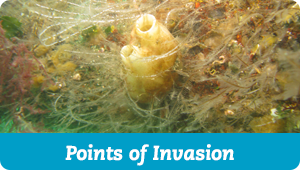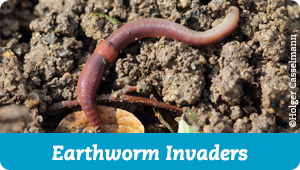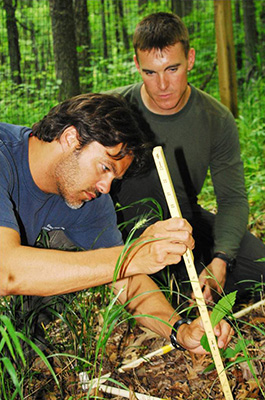
John Parker (left) measures tree saplings with intern Kiel Edson in an experimental forest plot. © Michael Tobias
Life in the forest understory can resemble life in a war zone. For many plants, every day is a battle as native plants struggle to hold onto their territory while invading plants seek to gain a foothold. Ecologists like John Parker watch the battle to answer two questions: Who wins, and why?
The outcome matters as much to people as it does to plants. Forests absorb CO2 from the atmosphere and filter out pollution from the water. They protect fish, oysters and other sea life by keeping harmful chemicals out of the Bay. If the forest landscape changes, it may not provide the same benefits. Invasive plants like kudzu and Japanese honeysuckle can strangle trees that—when alive—offer shelter and store CO2. Vast carpets of Japanese stiltgrass can stop new tree seedlings from growing at all. The impacts of different plant life reverberate throughout the food chain, on land and on sea.
Ultimate victory often depends on the forest. Or, more accurately, the forest’s history.
If a forest has been cut down for logging or agriculture, it often won’t grow back the way it was before, even if left alone. Extra sunlight gives invaders like Japanese stiltgrass (Microstegium vimineum) an opening. Native tree species that used to grow there soon find themselves smothered by non-natives.
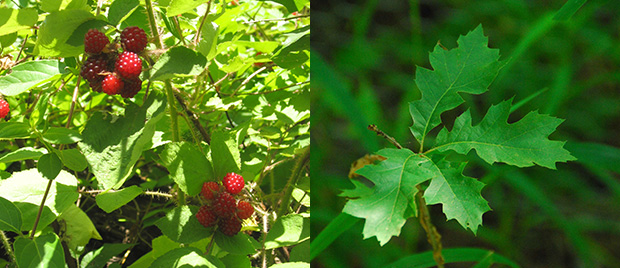
Wineberries, an invasive raspberry from Asia (left) and native red oak sapling (right). © Kiel Edson
Deer can impact the fate of a forest as well. Deer are often thought to prefer native over invasive plants. To get the full picture, Parker’s lab has surrounded large forest plots with mesh cages to create “a world without deer.” After five years, the world without deer so far has more thriving natives than the world with deer. But while deer pose a definite threat to natives, it’s unclear whether they actually help non-natives. Even though native plants did worse in plots exposed to deer, non-natives didn’t seem to follow up on their advantage.
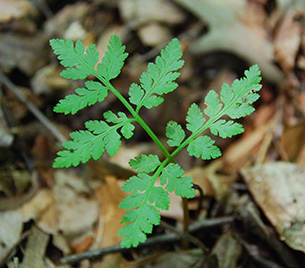 However, plants have also evolved their own defenses in warfare. Some defenses are chemical. Certain plants contain a flavor that hungry deer or insects won’t like. Caffeine in coffee plants and nicotine in tobacco originally evolved to keep herbivores away. Other defenses are physical. Holly leaves have sharp spines to ward off animals looking for food. Oak leaves have trichomes—thin spikes that feel like fuzz to humans but are like a field of broken glass to a small insect. And some leaves are just too tough for animals to bite into.
However, plants have also evolved their own defenses in warfare. Some defenses are chemical. Certain plants contain a flavor that hungry deer or insects won’t like. Caffeine in coffee plants and nicotine in tobacco originally evolved to keep herbivores away. Other defenses are physical. Holly leaves have sharp spines to ward off animals looking for food. Oak leaves have trichomes—thin spikes that feel like fuzz to humans but are like a field of broken glass to a small insect. And some leaves are just too tough for animals to bite into.
There are other threats to forest survival. Dutch elm disease has killed up to 100 million American elm trees since it was detected in the 1930s. Ash trees are facing attacks from a beetle known as the emerald ash borer. What our forests will look like in the future remains uncertain. Ecologists know one thing: Change within the forest will be felt far beyond its borders—in our rivers and bays, our food supply and in the planet’s shifting climate.
Learn more!
Discover how invasive white-tailed deer could transform a forest in the Terrestrial Ecology Lab.


 Learn about non-native plants in your area and the best ways to control them. The
Learn about non-native plants in your area and the best ways to control them. The 